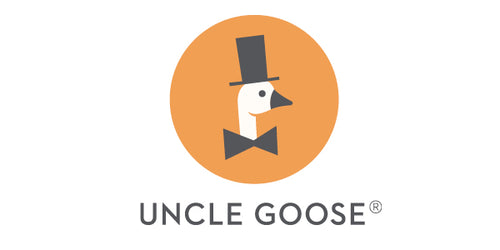
Who says all children’s toys have to be bright primary colors?
Highly-saturated primary and secondary colors: you see them on many children’s toys. But your Uncle Goose uses all kinds of carefully coordinated colors, from bright to subtle.
What’s wrong with us? Why aren’t we towing the corporate line when it comes to painting and packaging our toys?
After all, research shows that children tend to prefer bright colors. In part, this is because saturated colors are easier for young, developing eyes to see.
That’s why using bright, highly-saturated colors is a popular mass marketing technique. Bright colors attract the eye. And children tend to like bright colors even more than adults do.
Take a look around you. You can see how many beverage, food, and toy companies use bright colors to target children.
But color also affects mood and behavior. A steady diet of wild, clashing colors isn’t emotionally or intellectually satisfying for either children or adults.
Over-stimulation is a real concern. It can lead to crankiness and poor learning outcomes.
You don't want to be in "attraction and stimulation" mode at all times. You also need time for reflection and contemplation.
In other words: bright colors are terrific. They stimulate desire and attraction. We love to look at them. But we don’t want to look and play with them all the time!
 A subtle, coordinated color approach can enhance emotional and intellectual development.
A subtle, coordinated color approach can enhance emotional and intellectual development.
Even your favorite bright colors can yield more of an impact when paired with more subdued colors. To put it simply: a bright color “pops” when it’s next to something more subtle.
At Uncle Goose, we’re careful about our color choices. Color psychologists link color with brain development, enhanced productivity, and transitioning from childhood to adulthood.
That’s why you’ll see all kinds of carefully coordinated colors on our toys and blocks. Children are very aware of color. They react to them on both a physical and emotional level.
Conversation starters. Look for opportunities to have nuanced and instructive discussions about color with children. Their feelings and thoughts about color can change rapidly as they age. Use our blocks to help guide your conversations.
For example, you can pick up a block and ask children how yellow makes them feel. You might be surprised to discover that one child might find yellow relaxing - while another child might find it stimulating.
You also might be surprised to learn that some of your adult emotional understanding of color is different than a child’s. For example, you might think of red as an angry color: but a child may associate red as a happy color. What cultural conditioning may be at work here? Why do you feel the way you do? Why do children feel the way they do?
Look for opportunities to ask children about different shades of one color. For example, how do they feel about light blue? How do they feel about dark blue? Do they feel differently about each? Why or why not?
“What’s your favorite color?” is a popular question to ask children. Let them know it’s not a permanent answer! If your child picks one favorite color today, let them know it’s OK to have another favorite color next week.
They probably will! Depending on cultural conditioning, exposure, and physiological changes — children can learn to appreciate a wide variety of colors throughout their lifetimes.
There's more to life than bright primary and secondary colors. Children grasp the emotional impact of colors more than most adults can imagine!
